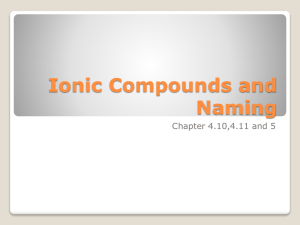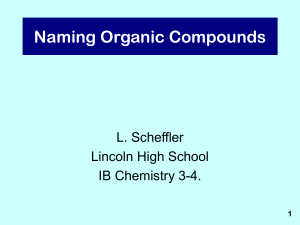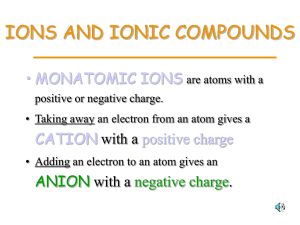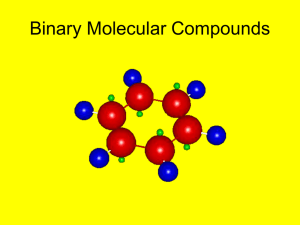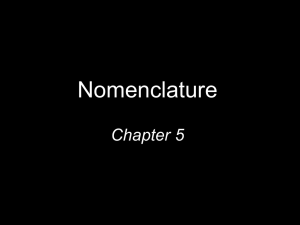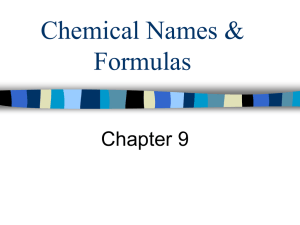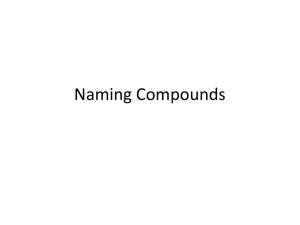Chemical Nomenclature
advertisement
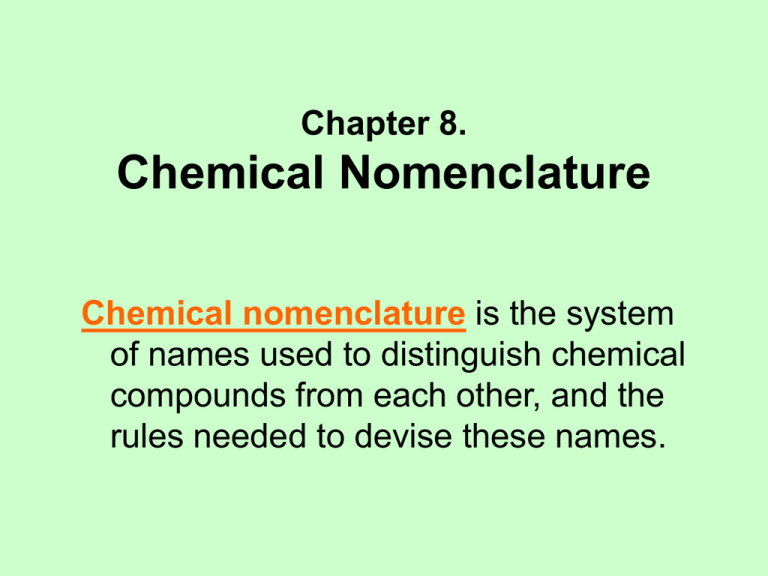
Chapter 8. Chemical Nomenclature Chemical nomenclature is the system of names used to distinguish chemical compounds from each other, and the rules needed to devise these names. Chemical Nomenclature Why Bother? How do you speak Al2(SO4)3 ? What system do we use? IUPAC International Union of Pure and Applied Chemistry Chemical Nomenclature Three major categories of compounds: Ionic First element in formula is a metal. Molecular First element in formula is a nonmetal. Acid First element in formula is Hydrogen. Naming Ionic Compounds Types of ionic compounds: Binary, contains two elements: NaCl, MgBr2, Fe2O3 Ternary, contains three elements; two are in a polyatomic anion: NaNO3, NH4Cl, Cr2(SO4)3 Naming Binary Ionic Compounds What is the charge on the metal ion? Fixed: Group 1A, +1; Group 2A, +2 Al3+, Ga3+, Zn2+, Cd2+, Ag1+ Examples: NaCl, Al2O3, CdS Name cation as element, e.g. sodium Name anion with stem of element name, followed by suffix ide, e.g. chloride Naming Binary Ionic Compounds What is the charge on the metal ion? Variable: All other metals Examples: CuO, FeBr2, Fe2O3 Name cation as element, followed by charge in Roman numerals, enclosed by parentheses, e.g. copper(II) Name anion with stem of element name, followed by suffix ide, e.g. oxide Naming Binary Ionic Compounds What is the charge on the metal ion? The compound must be electrically neutral. Use the charge on the anion to figure out the charge on the metal. Examples: FeO, Fe2O3 CuCl, CuCl2 SnF2, SnF4 Hg2Cl2, HgCl2 Naming Binary Ionic Compounds An older naming system gives the suffix ic to the ion with the higher charge, and the suffix ous to the ion with the lower charge, following the (usually Latin) element stem. FeO ferrous oxide; CuCl cuprous chloride SnF2 stannous fluoride Hg2Cl2 mercurous chloride Fe2O3 ferric oxide CuCl2 cupric chloride SnF4 stannic fluoride HgCl2 mercuric chloride Naming Ternary Ionic Compounds Name metal as you would for a binary, with charge if necessary. Name anion as itself. Know these: CO32NO31PO43SO42OH1- carbonate nitrate phosphate sulfate hydroxide ClO1- hypochlorite ClO31- chlorate C2H3O21- acetate CH3COO1- acetate CN1- cyanide Naming Ternary Ionic Compounds There is one polyatomic cation NH41+, ammonium Name it, then name anion properly Formulas from Names Write symbol for metal ion first, then anion. Use the charges on the ions to determine how many of each ion are present in the formula. Charges must sum to zero. If a polyatomic ion appears more than once in a formula, enclose it in parentheses, followed by a subscript showing the number of times the ion occurs in the compound. Practice Give Name CaCl2 Mg(NO3)2 Al2(SO4)3 FeCl3 AgBr MnO2 NH4NO3 Give Formula Mercurous iodide Mercury(II) iodide Silver nitrate Ammonium bromide Tin(II) hydroxide Sodium cyanide Calcium phosphate Naming Molecular Compounds These are all binary. Since the atoms do not have charges, use Greek numerical prefixes to indicate the number of each atom in the molecule. Know these: 1 mono 2 di 3 tri 4 tetra 5 penta 6 hexa Naming Molecular Compounds How to name them: 1. Prefix for first element in formula, omit if it's "mono" 2. Name first element 2. Prefix for second element in formula, 3. Give stem of second element followed by suffix ide. CO Carbon monoxide CO2 Carbon dioxide N2O Dinitrogen monoxide Naming Molecular Compounds Details and exceptions: If last letter of prefix for number and first letter of element are both vowels, drop the last letter of the prefix: CO carbon monoxide N2O5 dinitrogen pentoxide Some compounds are known only by common names. H2O water NH3 ammonia Formulas from Names Write symbol for least electronegative element first, then most electronegative. Use prefixes to determine subscripts in formula. Metalloids are not metals, and their compounds are named as molecular compounds. Practice Give Name NO2 SO3 SiO2 TiO2 NO P2O5 Fe2O3 Give Formula Carbon tetrachloride Phosphorus trichloride Selenium dibromide Dinitrogen tetroxide Sulfur dioxide Xenon tetrafluoride Diantimony Trioxide Naming Acids Types of acids: Binary, contains two elements: HCl, HBr, H2S Ternary, contains three elements; two are in a polyatomic ion: HNO3, H2SO4, H3PO4 Naming Binary Acids Binary acids are gases as pure compounds. Symbol: HCl or HCl (g) Name: hydrogen + stem of nonmetal followed by suffix -ide. hydrogen chloride Naming Binary Acids The compounds become acidic in water solution (aqueous solution); they ionize. HCl + H2O H3O1+ + Cl1- H3O1+ is what makes acids acidic. Symbol: HCl (aq) Name: prefix hydro- + stem of nonmetal followed by suffix -ic acid. hydrochloric acid Naming Ternary Acids No distinction is made between pure ternary acids and those in aqueous (water) solution. Symbol: H2SO4 Name: stem of central atom followed by suffix -ic acid. sulfuric acid Naming Ternary Acids Know names of these ternary acids. They are related to "must know" polyatomic anions: H2CO3 HNO3 H3PO4 H2SO4 HOH HClO HClO3 HC2H3O2 CH3COOH HCN (aq) Naming Acids and Anions Useful Generalization: If the name of an anion ends in -ide, its aqueous acid is named as hydrostemic acid. If the name of an anion ends in -ate, its acid is named as stemic acid. Practice Give Name HBr (aq) HNO3 H 2O H 2S HF H3PO4 HI (aq) Give Formula Sulfuric acid Carbonic acid Hydrogen iodide Hypochlorous acid Hydrocyanic acid Acetic acid Chloric acid Naming Mixed Salts Mixed salts are compounds in which Na1+ or K1+ combine with H1+ and an anion with -2 or -3 charge. Symbol: KHSO4 Name: metal cation, hydrogen, anion Potassium hydrogen sulfate Naming Mixed Salts If the anion has -3 charge (PO43-), three cations are required to form a neutral compound. Symbol: NaH2PO4 Name: metal cation, prefix di-hydrogen, anion Sodium dihydrogen phosphate Symbol: K2HPO4 Name: prefix di-metal cation, hydrogen, anion Dipotassium hydrogen phosphate More Practice Give Name AgNO3 CaS NH3 NaHS ZrO2 H2SO4 Al2O3 Give Formula Magnesium sulfate Ferric chloride Nitric acid Lead(IV) sulfate Sodium hydrogen carbonate Mercuric bromide Phosphorus trifluoride


